Return path of currentNeutral
The neutral, white-colored wire is the return path of electricity. Ex: when a lamp is powered up, electricity flows from the mains to the lamp on a hot (black) wire and returns to the mains through the neutral (white) wire. (Exhibit 1) The hot and the neutral make the circuit “complete” to light the lamp. The lamp will not light if there is any breakage in the hot or the neutral wires.
Fault CurrentGround
The ground, green-colored wire is the safety wire to provide a path of electricity when any metal parts touch the hot or neutral wire. Ex: A motor metal casing is connected to the ground wire. If a hot or neutral inside the motor touches the casing, the casing will be energized, resulting in a “fault current” through the ground wire. The ground wire (green) safely moves that fault current into the breaker panel, tripping the circuit. Exhibit 1 shows the path of electricity in neutral and ground.
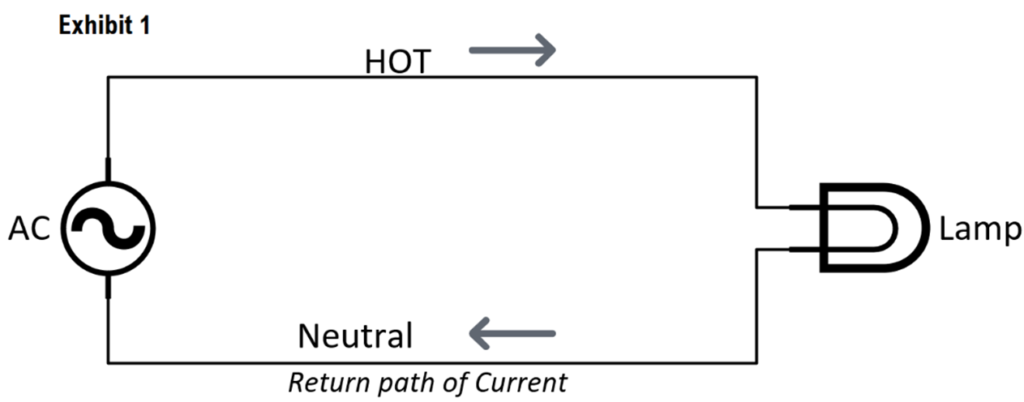
Neutral is the return path of current

Ground is for safety
Needed for good power qualityGrounding and Bonding
Grounding and bonding are two different words often misused in the market. In simple terms, grounding connects to the earth, whereas bonding is the connection established to maintain electrical continuity and conductivity. Both grounding and bonding are essential to maintain a building’s electrical safety.
Let’s take an example of a typical US-based single-family home with a 120V system to understand the concepts better. The system has two hots (black and red), one neutral (white), and one ground (green).
US residential panelThe Structure of home electrical panels
The majority of the homes have their electrical meters installed outside the building with a service disconnect (service equipment). The load panel (Lug main breaker panel) is installed inside the house, feeding to the different loads of the house (Exhibit 3). Few homes may have their service disconnect and the load breakers in the same panel, making the service equipment and lug main breaker panel into one unit (Exhibit 2).

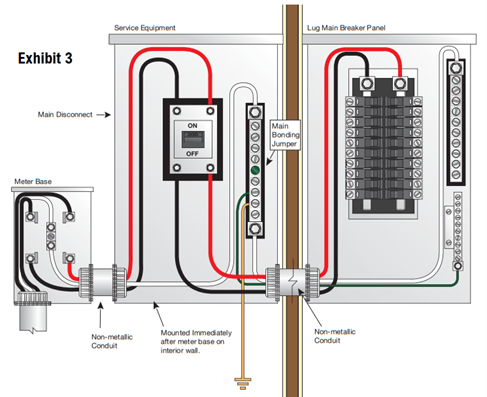
Grounding protects your facility from over-voltages.
Grounding or earthing limits the over-voltages from lightning, surges, and faults by diverting them to the earth through grounding rods. While there is usually only one grounding rod (into the earth) outside the building, there could be several grounding electrodes in the system. The NEC recommends using the following seven types of grounding electrodes that are present in a system:
- Metal underground water pipe
- The metal frame of the building
- Concrete encased electrode
- Ground ring
- Rod and pipe electrodes
- Other listed electrodes
- Plate electrodes
Exhibit 4 shows the various grounding electrodes and the grounding rod in a system.

The grounding electrodes are either connected 1) all of them to the grounding rod 2) from one conductor to another using a bonding jumper and then to the grounding rod 3) combination of both (1) and (2). See Appendix A for reference.
The over-voltage or the fault currents take the path of grounding electrodes to the grounding rod or to the over-voltage protective devices.
Why is ground wire necessary?
Any metal casing electrical load should have a ground wire. The purpose of the ground wire is to trip the breaker in the event of fault current safely. If the ground wire is not connected correctly or missing, it will cause a severe electric shock to the person and harm the building. Ex: Motor metal casing is connected to the ground using a green ground wire. If the ground wire is broken or does not trip the breaker in the event of a fault current – then the motor’s metal casing is energized, resulting in a severe electrical shock to the person when he touches it. If the system has multiple casings connected to that motor grounding point, other loads’ casings will pose a serious electric shock. Loose lugs and connectors might result in an arc over flash and fire hazard. Therefore, a properly connected grounding wire is essential for the safety of personnel and the building.
The ground and neutral wires are connected at the main panel ONLY
NEC 2008 states that the neutral and ground wires should be “bonded” together at the main panel (only) to the grounding rod. Assuming that the ground rod is properly installed with excellent earth bonding, the rod should carry away the externally generated surges like lightning into the earth – protecting the house and building.
The purpose of the ground wire is always “safety.” Ground wires are:
- Never intended to carry any current during normal operations
- It intended to hold the fault current to the main panel to trip the breaker, and nobody gets hurt.
The ground and neutral must have separate paths downstream of the main panel. But if you connect the neutral and ground the downstream (at the subpanels)
- The ground carries current to the main panel – creating multiple return paths of electricity
- Neutral breakers might not trip in the event of fault since their load is shared with the ground.
- The bare copper wires in the subpanel are now holding current – a potential threat for an electric shock to the personnel
Therefore, the main panel is the ONLY location in your home, in other buildings and structures supplied by this main panel (service equipment) – where the neutral and ground are connected. The branch circuits or the subpanels should have their neutral wire isolated from:
- Ground wire
- All equipment grounding conductors, metallic parts, enclosures etc.
Exhibit 5,7 shows the proper ways of grounding. Exhibit 6,8 shows the violations.
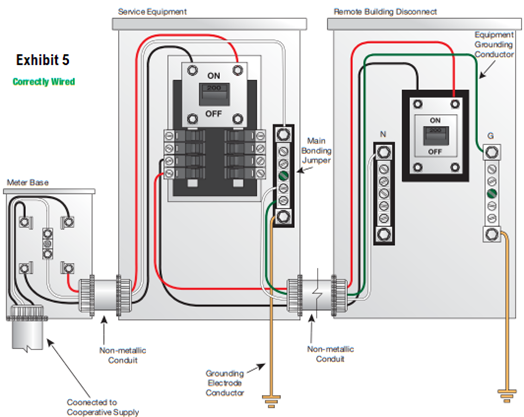
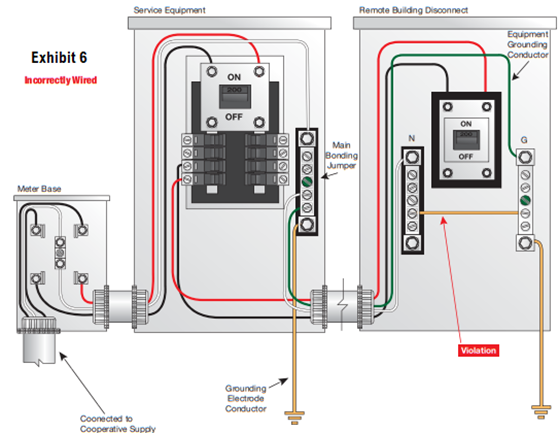
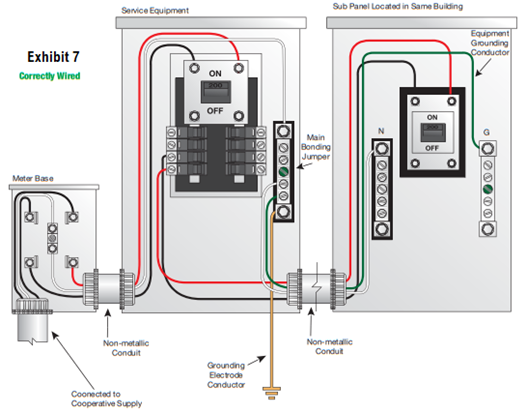
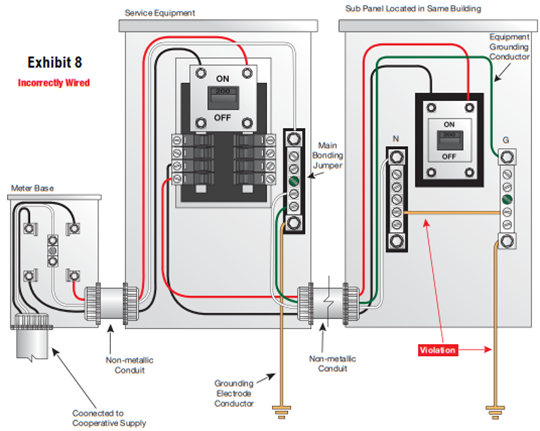
Ground loops
Depending on the type of soil and the nature of the loads used in a facility, multiple ground rods, like shown in Exhibit 5, can create ground loops. The ground loops circulate ground currents (not necessarily fault currents) amongst themselves, expanding the unwanted currents to the rest of the facility. Ground loops are the most common power quality issues in multifamily homes, commercial and industrial facilities. To reduce the ground loops, it is recommended to follow the setup in Exhibit 7, where the subpanel’s ground is pulled through the ground wire connecting the Service Equipment.
NOTE: It is legal to add multiple ground rods a specific minimum distance and connect them to the original main entrance ground rod (Like in Exhibit 5). However, it is illegal to ground the subpanels to separate earth grounding system (taking out the ground wire connection from the main panel to the subpanel).
Noise and Surge sharing from neighbors?
Multifamily homes might share the same ground rod and electrodes at their service meters. Improper use of ground and neutral results in the fault current and noise to the main service center’s ground. Since the grounds between the neighbors are shared, the noise and fault current will also share, degrading the neighborhood’s power quality. Exhibit 9 shows four different grounding rods from the neighbors and sharing of noise/current (red lines) between them.

Summary
Proper grounding is essential for safety and good power quality. Neutral is the return path of the current, and ground wire holds the fault current to trip the breaker in protecting the person and the facility. The neutral and ground should never be bonded together in the facility except for the main panel. Improper use of grounding may result in poor power quality, ground loops, and sharing noise/surges between neighbors.
Appendix
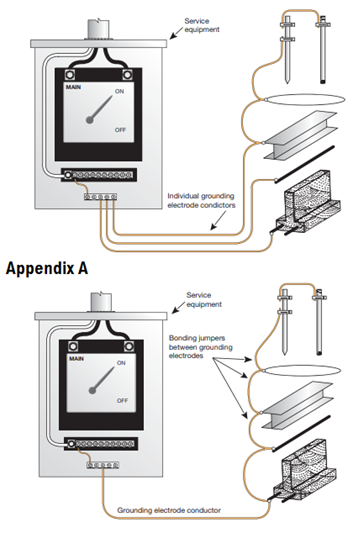
Safety and Disclaimer: A certified, qualified professional/electrician must perform the electrical installations and maintenance. Qualified electricians are encouraged to review the National Electric Code (NEC) 2008 Ed, and other standards published by National Fire Protection Association (NFPA) 70E-2004. EP does not hold responsible for any personal injury, property damage, or other damages of any kind, whether special, indirect, consequential, or compensatory, directly or indirectly resulting from the publication, use or reliance on the material contained in the following specifications. Whether express or implied, no warranties are made as to the accuracy or completeness of the information contained herein.
Citations:
- The images and content from the following article is reused: Grounding & Bonding – Why it is done and How to install properly by Adams Electric Cooperative, Inc – A touchstone Energy Cooperative
- NEC Code 2008 Ed

